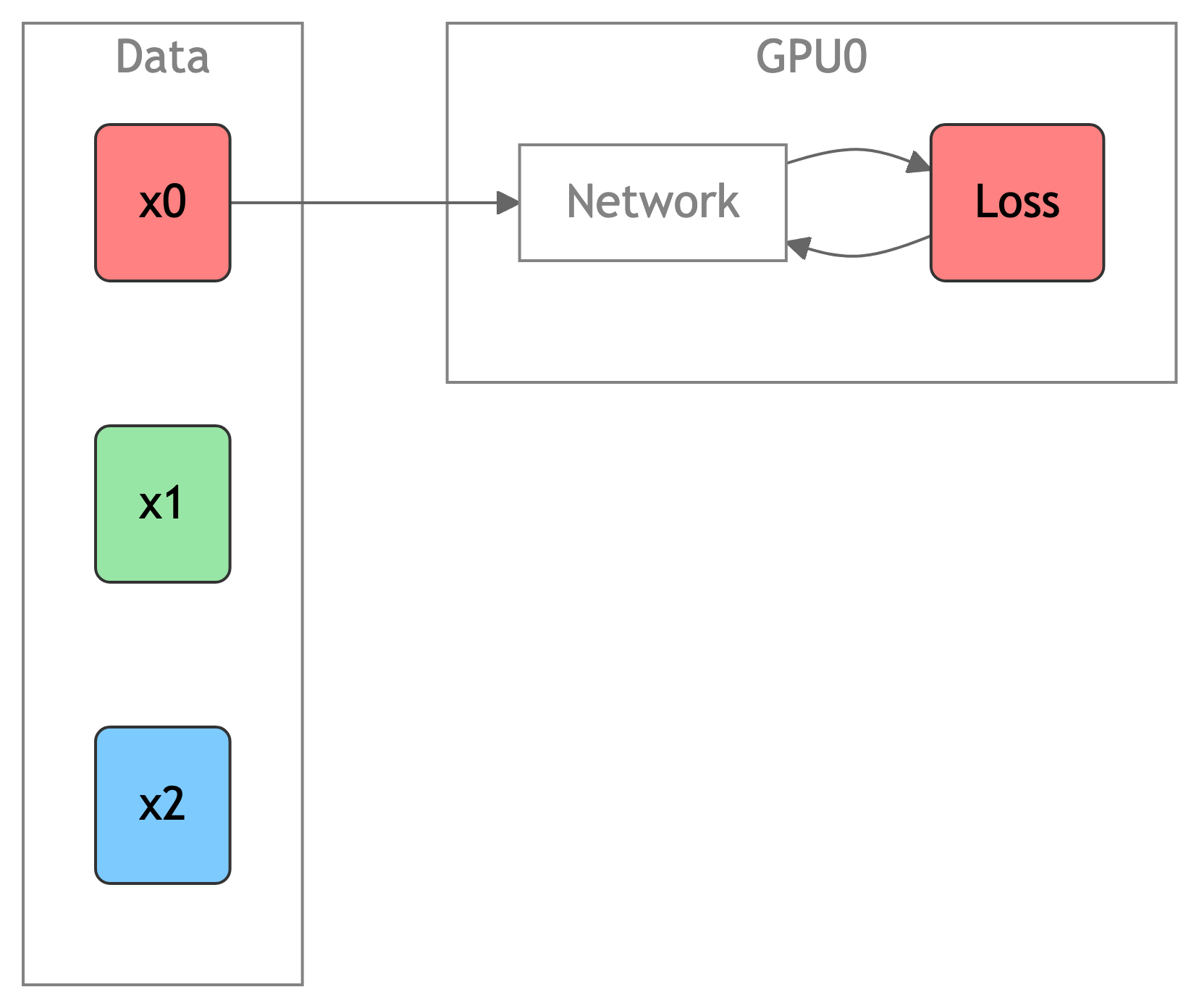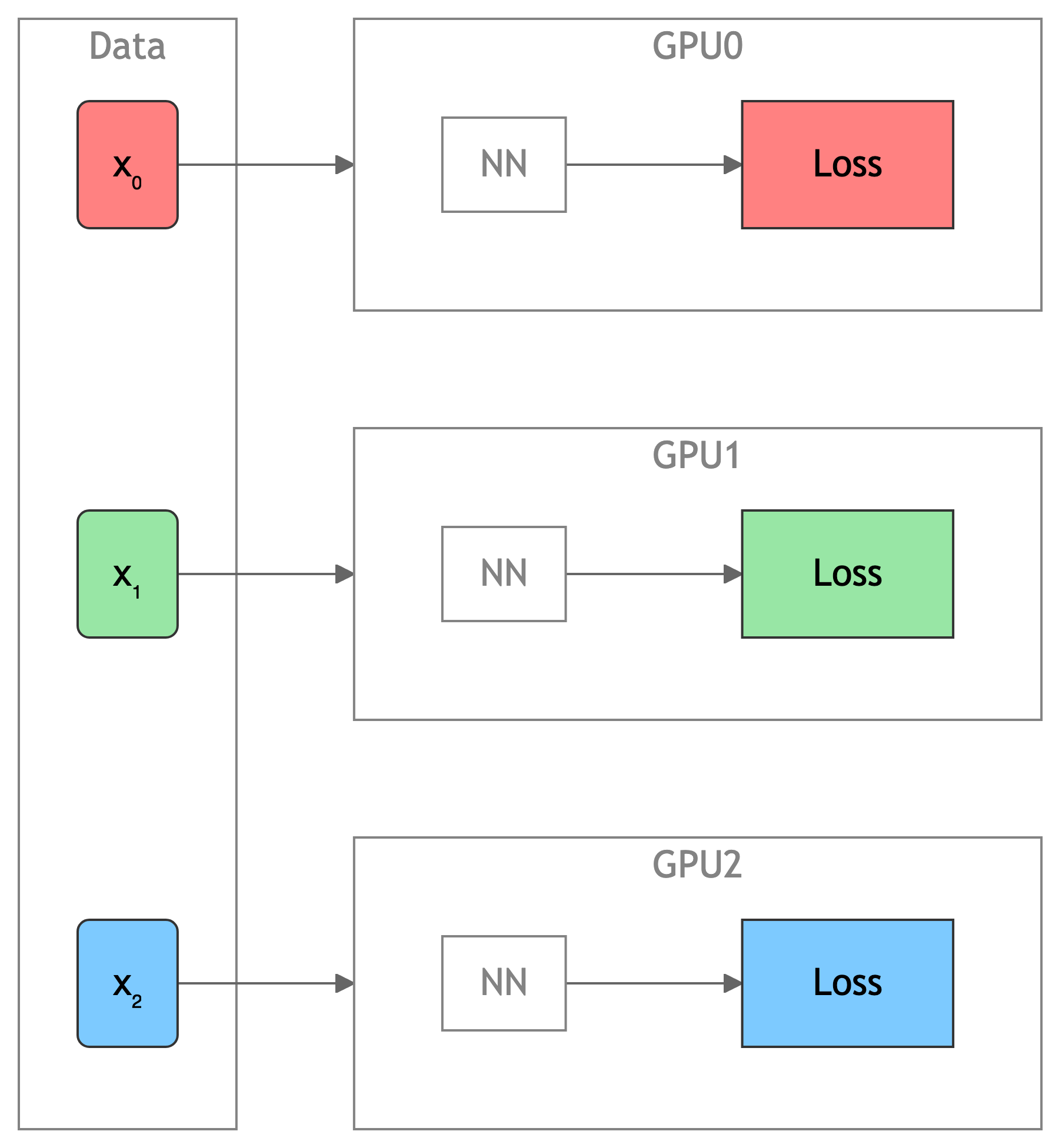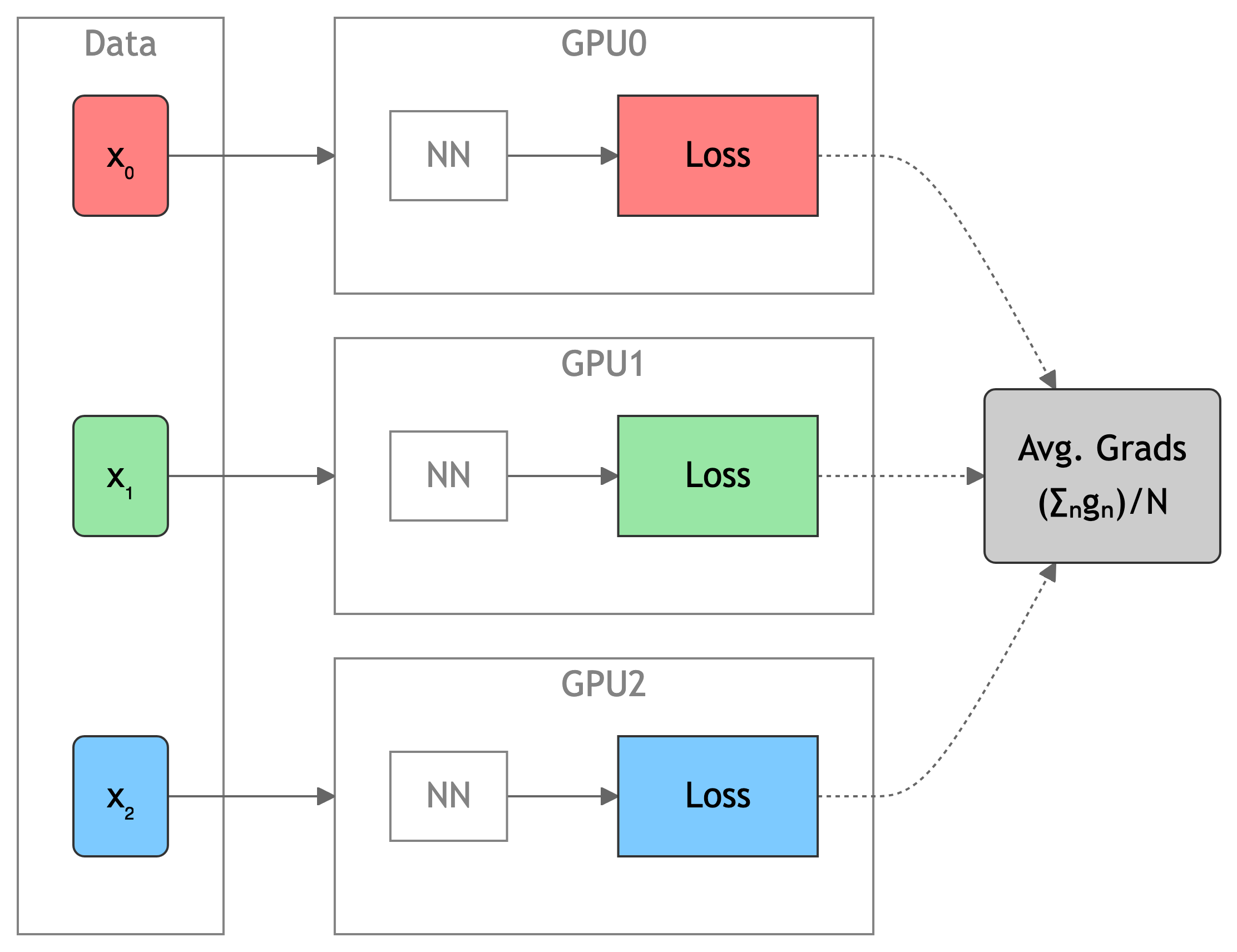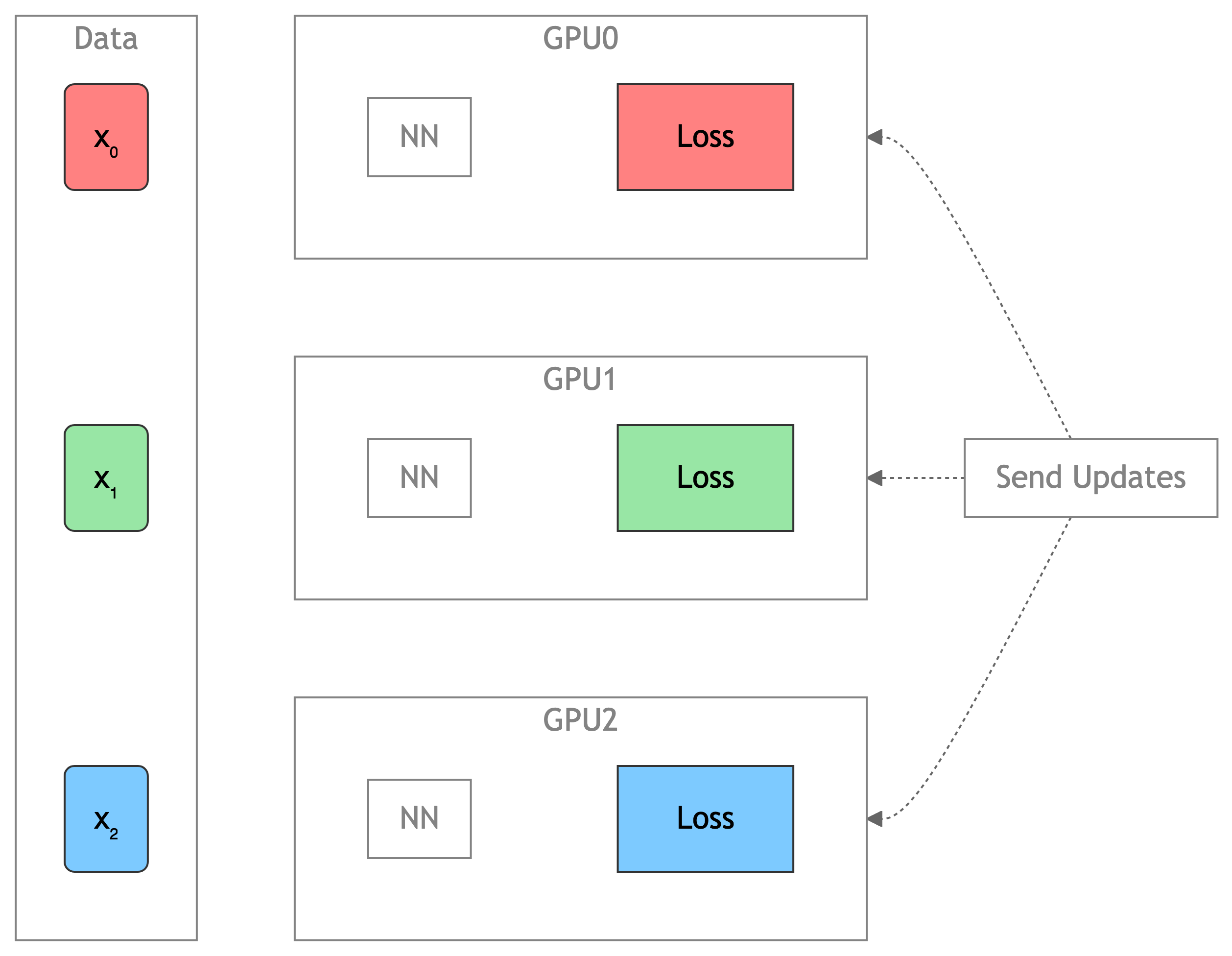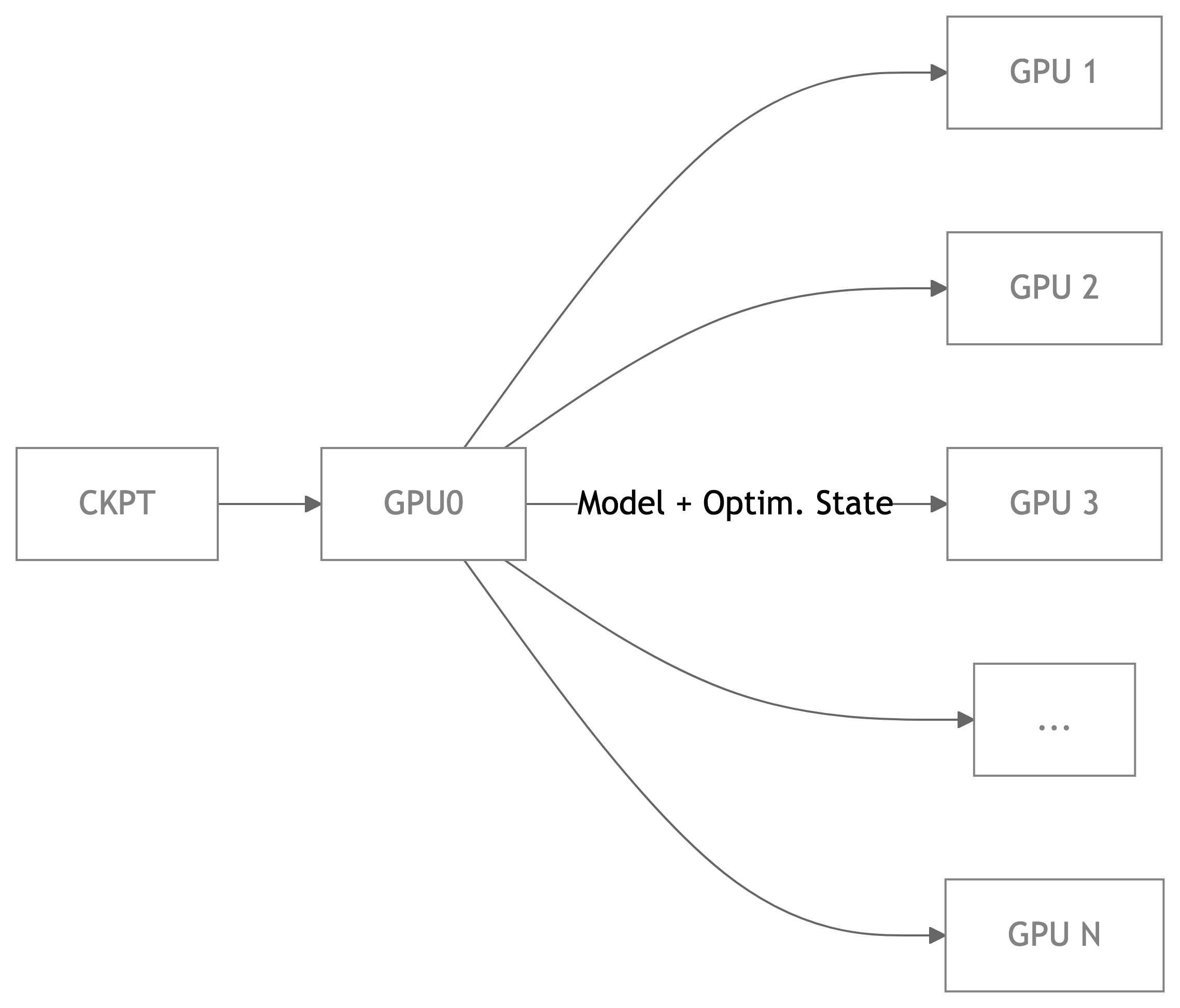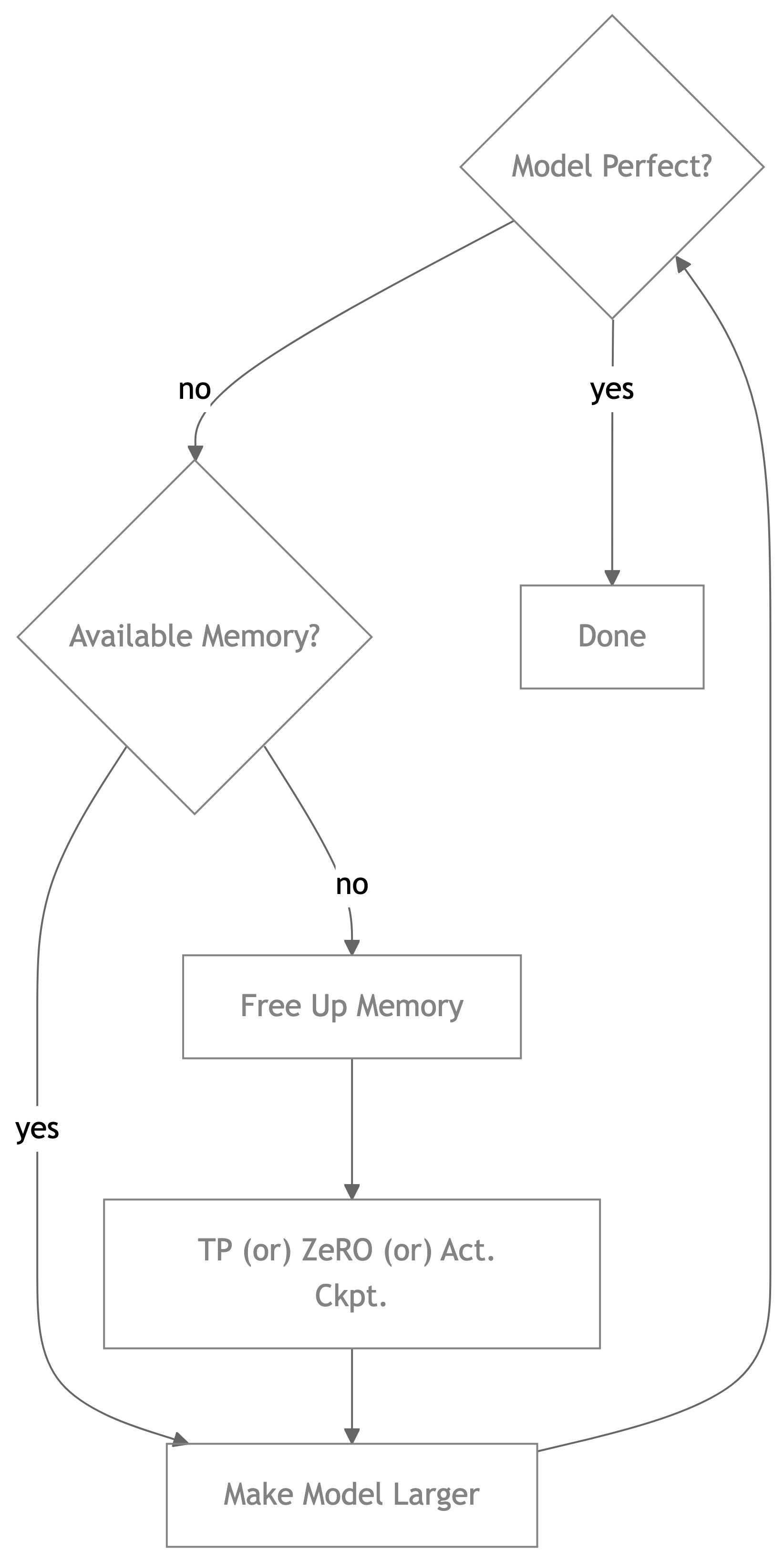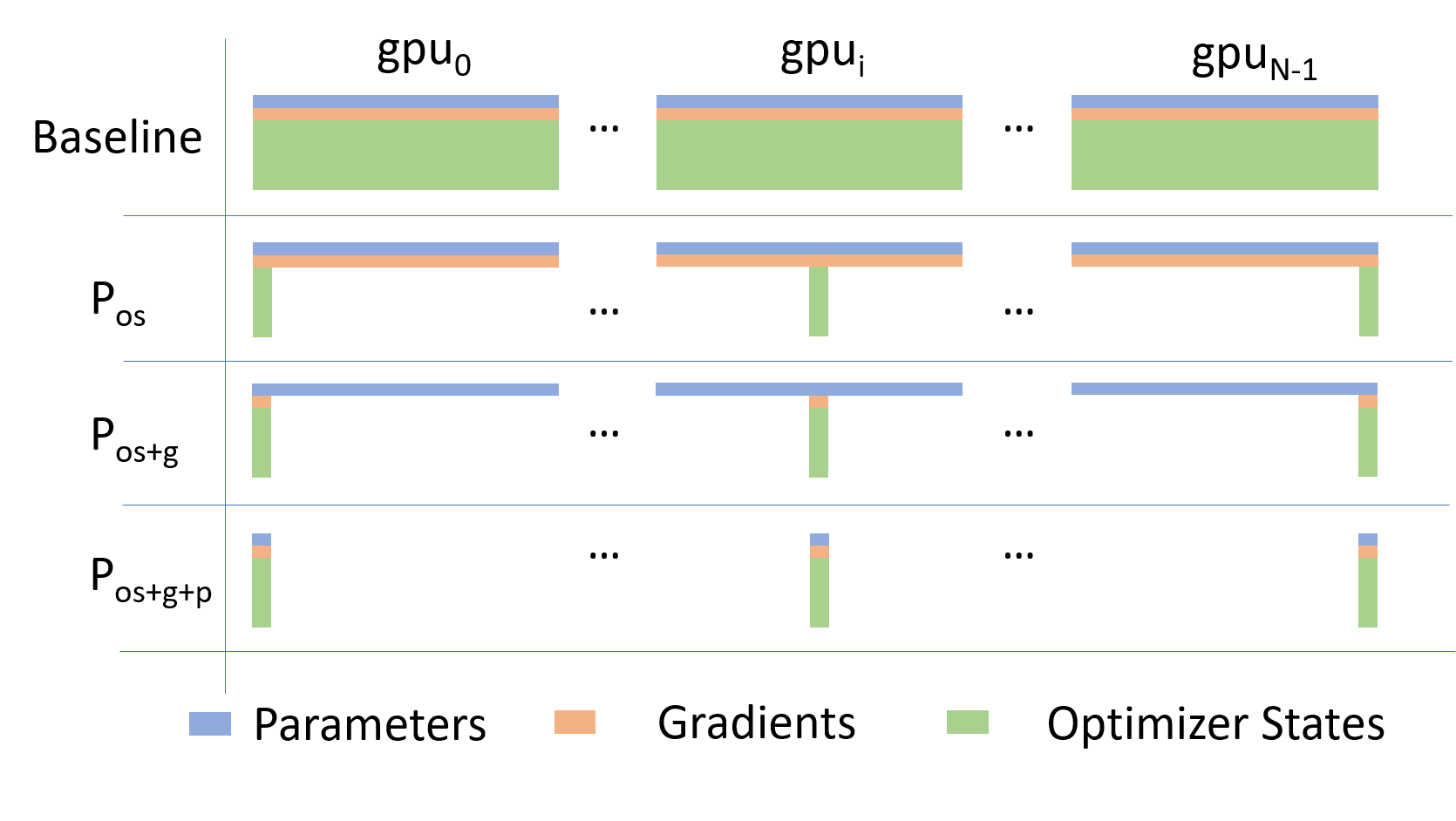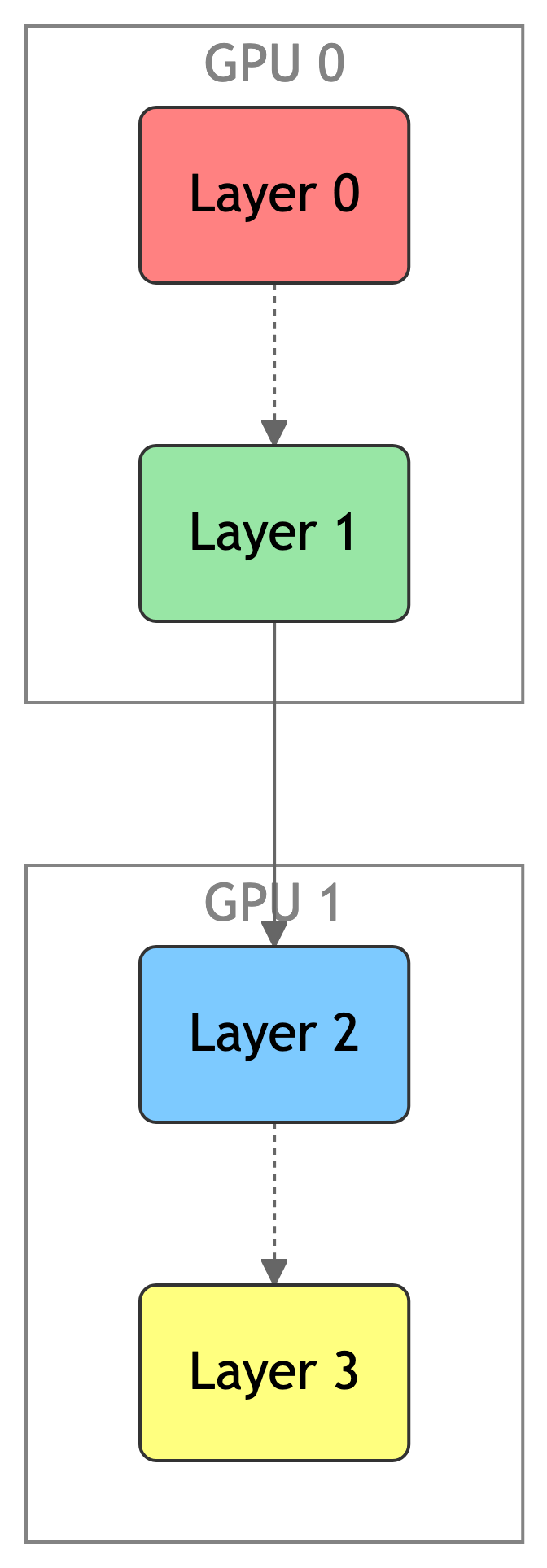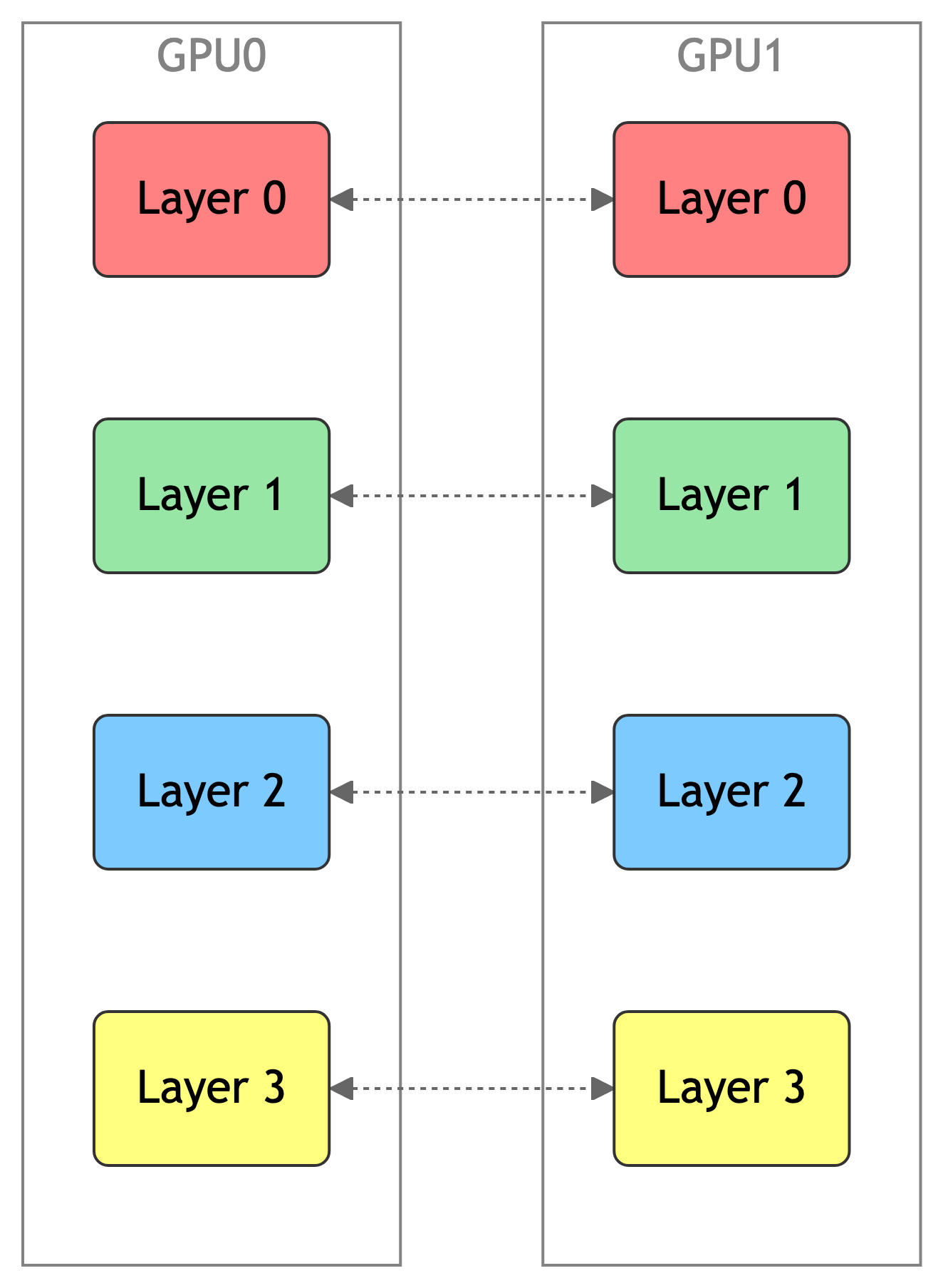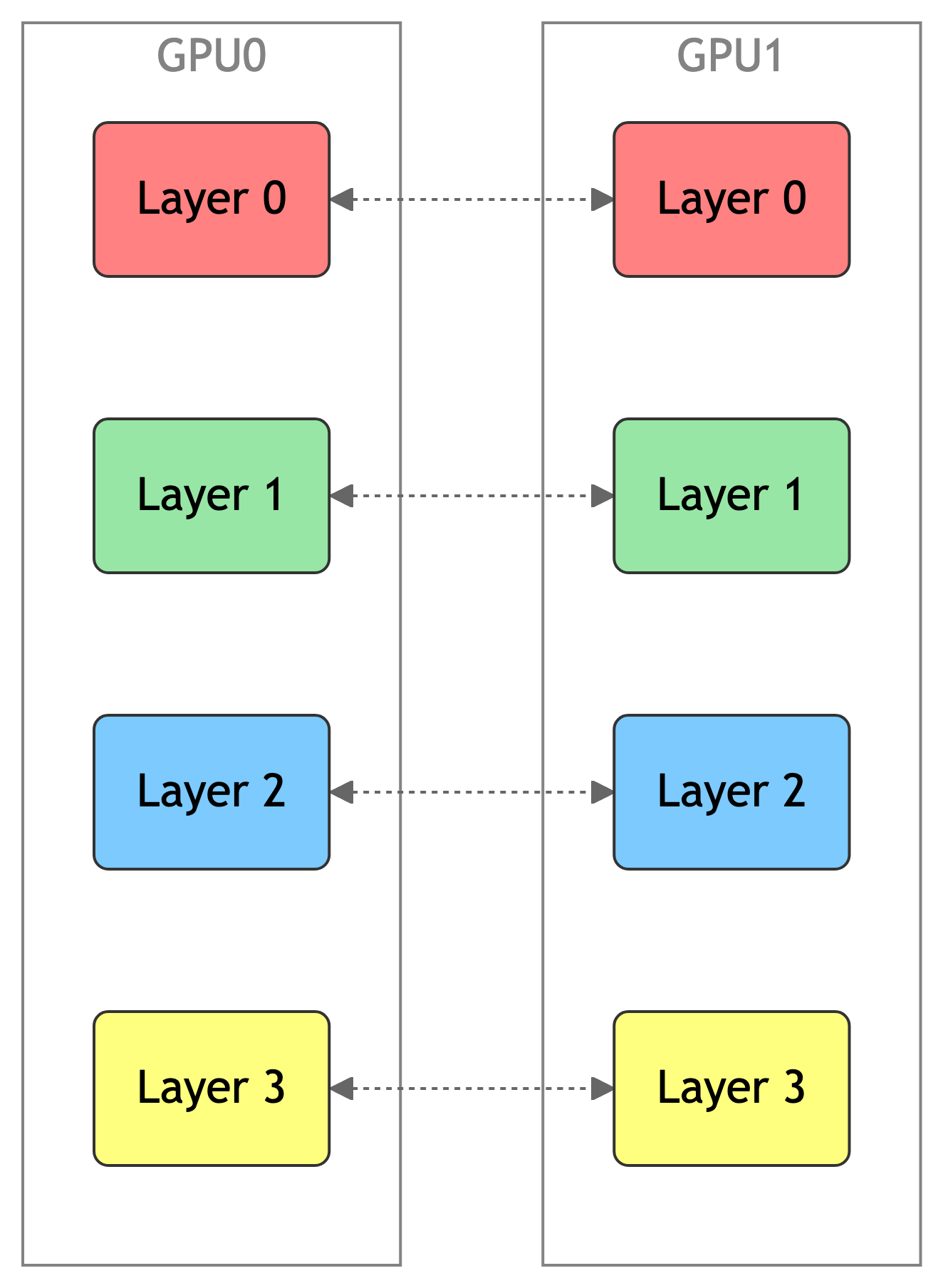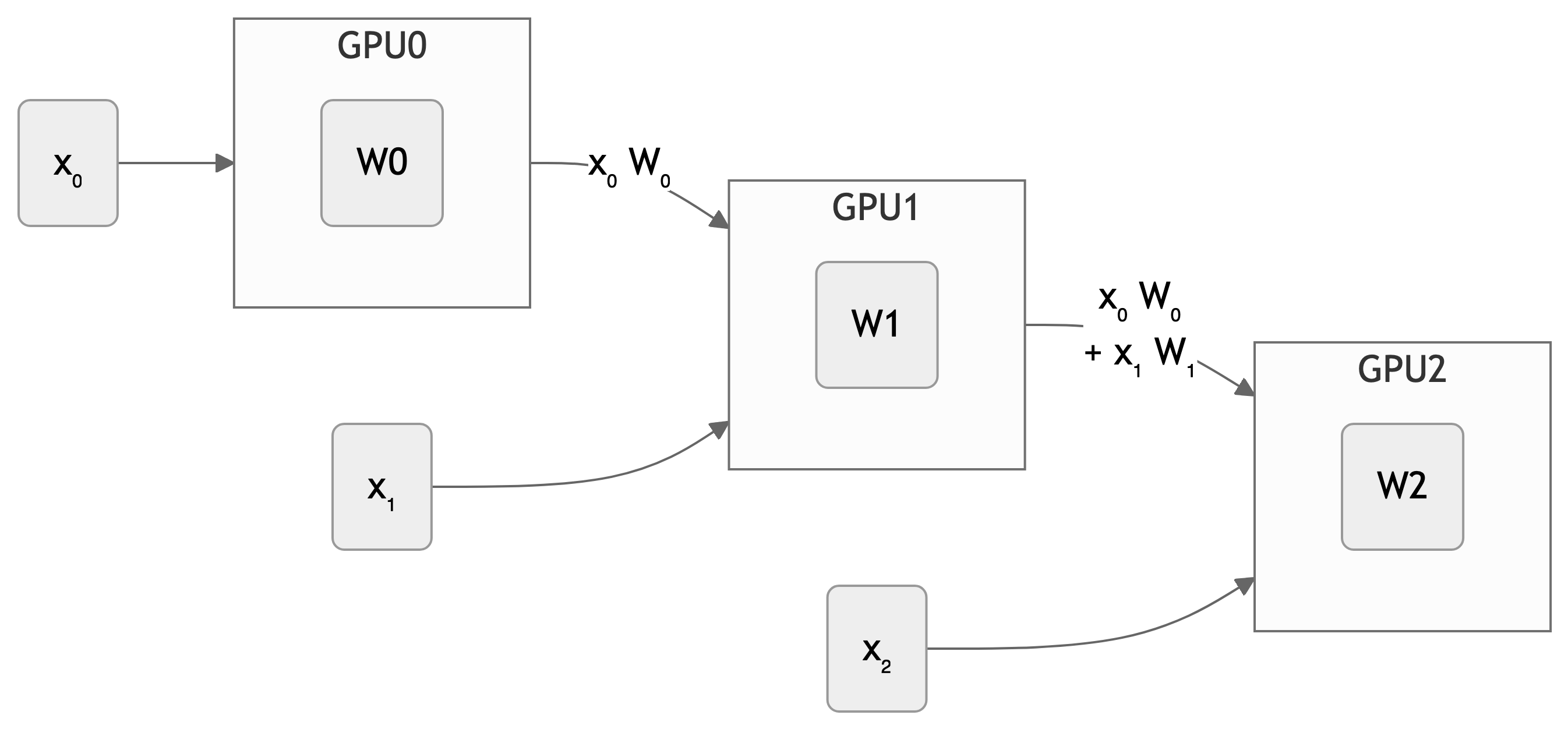Training Foundation Models on Supercomputers
2025-09-24
👀 Scaling: Overview
- ✅ Goal:
- Minimize: Cost (i.e. amount of time spent training)
- Maximize: Performance
📑 Note
See 🤗 Performance and Scalability for more details
🐢 Training on a Single Device
- See also:
👬 Training on Multiple GPUS: Data Parallelism
➡️ Data Parallel: Forward Pass
⬅️ Data Parallel: Backward Pass
🔄 Data Parallel: Training
- Each GPU:
- has identical copy of model
- works on a unique subset of data
- Easy to get started (minor modifications to code):
📡 Communication
- Requires global communication
- every rank must participate (collective communication) !!
- Need mechanism(s) for communicating across GPUs:
- Collective Communication:
⌛ Timeouts
- Collective operations have to be called for each
rankto form a complete collective operation.- Failure to do so will result in other ranks waiting indefinitely
🚧 Common Pitfalls
- Each worker needs to be fed a unique batch of data at each step
- Only perform File I/O on one worker (i.e.
rank==0)- When loading from a checkpoint, read in on one worker and broadcast to others
- Collective operations must be called by all workers
- Ensure that all workers are using the same version of code / libraries
🎀 Best Practices
- Use parallel IO whenever possible
- Feed each rank from different files
- Use MPI IO to have each rank read its own batch from a file
- Use several ranks to read data, MPI to scatter to remaining ranks
- Most practical in big at-scale training
- Take advantage of data storage
- Use the right optimizations for Aurora, Polaris, etc.
- Preload data when possible
- Offloading to a GPU frees CPU cycles for loading the next batch of data
- minimize IO latency this way
- Offloading to a GPU frees CPU cycles for loading the next batch of data
⏰ Keeping things in Sync
Computation stalls during communication !!
Keeping the communication to computation ratio small is important for effective scaling.
🤔 Plan of Attack
🚀 Going Beyond Data Parallelism
- ✅ Useful when model fits on single GPU:
- ultimately limited by GPU memory
- model performance limited by size
- ⚠️ When model does not fit on a single GPU:
- Offloading (can only get you so far…):
- Otherwise, resort to model parallelism strategies
Going beyond Data Parallelism: ZeRO
- Depending on the
ZeROstage (1, 2, 3), we can offload:- Stage 1: optimizer states (Pos)
- Stage 2: gradients + opt. states (Pos+g)
- Stage 3: model params + grads + opt. states (Pos+g+p)
🕸️ Additional Parallelism Strategies
- Tensor (/ Model) Parallelism (
TP): - Pipeline Parallelism (
PP): - Sequence Parallelism (
SP): -
- Supports 4D Parallelism (
DP+TP+PP+SP)
- Supports 4D Parallelism (
Pipeline Parallelism (PP)
- Model is split up vertically (layer-level) across multiple GPUs
- Each GPU:
- has a portion of the full model
- processes in parallel different stages of the pipeline (on a small chunk of the batch)
- See:
Tensor Parallel (TP)
- Each tensor is split up into multiple chunks
- Each shard of the tensor resides on its designated GPU
- During processing each shard gets processed separately (and in parallel) on different GPUs
- synced at the end of the step
- See: 🤗 Model Parallelism for additional details
Tensor Parallel (TP)
- Suitable when the model is too large to fit onto a single device (CPU / GPU)
- Typically more complicated to implement than data parallel training
- This is what one may call horizontal parallelism
- Communication whenever dataflow between two subsets
-
argonne-lcf/Megatron-DeepSpeed - 🤗
huggingface/nanotron
Tensor (/ Model) Parallel Training: Example
Want to compute: y=∑ixiWi=x0∗W0+x1∗W1+x2∗W2
where each GPU only has only its portion of the full weights as shown below
- Compute: y0=x0∗W0→
GPU1 - Compute: y1=y0+x1∗W1→
GPU2 - Compute: y=y1+x2∗W2=∑ixiWi ✅
🧬 MProt-DPO: Scaling Results
~ 4 EFLOPS @ Aurora
38,400 XPUs
= 3200 [node]
x 12 [XPU / node]🔔 2024 ACM Gordon Bell Finalist (Dharuman et al. (2024)):
MProt-DPO: Breaking the ExaFLOPS Barrier for Multimodal Protein Design Workflows
🌎 AERIS: Scaling Results
- 10 EFLOPs (sustained) @ 120,960 GPUs
- See (Hatanpää et al. (2025)) for additional details
- arXiv:2509.13523
🍋 ezpz
Write once, run anywhere
Setup (optional1):
Install:
See also:
🍋 ezpz @ ALCF
Polaris:
uv venv --python=3.12 source .venv/bin/activate module use /soft/modulefiles module load gcc-native cudatoolkit/12.8.1 uv pip install uv pip install --no-cache --link-mode=copy torch torchvision torchaudio transformers deepspeed datasets accelerate torchinfo CC=mpicc CXX=mpicxx uv pip install --no-cache --link-mode=copy --no-binary=mpi4py mpi4py uv run --with "git+https://github.com/saforem2/ezpz@saforem2/tests" --with "numpy<2" ezpz-test
🐣 Getting Started
Submit interactive job:
Source1 the
ezpz/bin/utils.shscript (usingcurlto download it2):
🏖️ Shell Environment
Setup environment:
🔍 Environment Setup with ezpz_setup_env
- Wrapper around
ezpz_setup_job&&ezpz_setup_python
ezpz_setup_job: Determine the specifics of our active (PBS, SLURM) job1ezpz_setup_python:- if @ ALCF:
- Load the appropriate modules and activate base
condaenv
- Load the appropriate modules and activate base
- else:
- Look for an active
condaenvironment- If found, use it to build a new virtual environment
- Look for an active
- Activate the newly created
venvs/$(basename ${CONDA_PREFIX})environment
- if @ ALCF:
⏱️ Working with Job Scheduler(s)
ezpzintegrates directly with your favorite job scheduler (PBS, slurm)- has mechanisms for getting information about our currently running jobs
- 🪄 Automagically:
- Determine the specifics of our active (PBS, SLURM) job
(e.g.${NHOSTS},${NGPU_PER_HOST},${NGPUS}, …) - Load the appropriate modules1
- Create (or activate) a virtual environment on top of a base conda environment
- Determine the specifics of our active (PBS, SLURM) job
🐍 Python Environments
- ALWAYS work inside a virtual environment
- best practice is to maintain separate virtual environments for:
- each project you work on
- different versions of a specific package you’re working with
e.g you would want different envs fortorch==2.Xvstorch==2.Y
- Mangled python environments are one of the most common issues faced by users
- best practice is to maintain separate virtual environments for:
🧪 Simple Distributed Test
Run distributed test:
Launch any python from python
Launch a module:
Launch a python string:
➕ How to Modify Existing Code
✨ Features
Initializing PyTorch across multiple processes
Automatic device detection (
xpu,cuda,mps,cpu, …)Automatic (single-process) logging
Distributed debugger:
🧪 Experiment Tracking
import ezpz
rank = ezpz.setup_torch()
logger = ezpz.get_logger(__name__)
if rank == 0: # -- [1.] --
try:
_ = ezpz.setup_wandb(
"ezpz.examples.minimal"
)
except Exception:
logger.exception(
"Failed to initialize wandb, continuing without it"
)
# ...build {model, optimizer}, etc...
for i in range(train_iters):
metrics = train_step(...)
logger.info( # -- [2.] --
history.update(metrics) # -- [3.] --
)
if rank == 0:
history.finalize()- Initialize W&B (if
WANDB_DISABLEDis not set) - Log summary of metrics to stdout
- Update
history.historywith metrics1
🤏 Minimal Example
import os
import time
import ezpz
import torch
logger = ezpz.get_logger(__name__)
class Network(torch.nn.Module):
def __init__(
self,
input_dim: int,
output_dim: int,
sizes: list[int] | None,
):
super(Network, self).__init__()
nh = output_dim if sizes is None else sizes[0]
layers = [torch.nn.Linear(input_dim, nh), torch.nn.ReLU()]
if sizes is not None and len(sizes) > 1:
for idx, size in enumerate(sizes[1:]):
layers.extend(
[torch.nn.Linear(sizes[idx], size), torch.nn.ReLU()]
)
layers.append(torch.nn.Linear(sizes[-1], output_dim))
self.layers = torch.nn.Sequential(*layers)
def forward(self, x: torch.Tensor) -> torch.Tensor:
return self.layers(x)
@ezpz.timeitlogit(rank=ezpz.get_rank())
def train(
model: torch.nn.Module, optimizer: torch.optim.Optimizer
) -> ezpz.History:
unwrapped_model = (
model.module
if isinstance(model, torch.nn.parallel.DistributedDataParallel)
else model
)
history = ezpz.History()
device_type = ezpz.get_torch_device_type()
dtype = unwrapped_model.layers[0].weight.dtype
bsize = int(os.environ.get("BATCH_SIZE", 64))
isize = unwrapped_model.layers[0].in_features
warmup = int(os.environ.get("WARMUP_ITERS", 10))
log_freq = int(os.environ.get("LOG_FREQ", 1))
model.train()
for step in range(int(os.environ.get("TRAIN_ITERS", 500))):
with torch.autocast(
device_type=device_type,
dtype=dtype,
):
t0 = time.perf_counter()
x = torch.rand((bsize, isize), dtype=dtype).to(device_type)
y = model(x)
loss = ((y - x) ** 2).sum()
dtf = (t1 := time.perf_counter()) - t0
loss.backward()
optimizer.step()
optimizer.zero_grad()
dtb = time.perf_counter() - t1
if step % log_freq == 0 and step > warmup:
logger.info(
history.update(
{
"iter": step,
"loss": loss.item(),
"dt": dtf + dtb,
"dtf": dtf,
"dtb": dtb,
}
)
)
return history
@ezpz.timeitlogit(rank=ezpz.get_rank())
def setup():
rank = ezpz.setup_torch()
if os.environ.get("WANDB_DISABLED", False):
logger.info("WANDB_DISABLED is set, not initializing wandb")
elif rank == 0:
try:
_ = ezpz.setup_wandb(
project_name=os.environ.get(
"PROJECT_NAME", "ezpz.examples.minimal"
)
)
except Exception:
logger.exception(
"Failed to initialize wandb, continuing without it"
)
device_type = ezpz.get_torch_device_type()
model = Network(
input_dim=int((os.environ.get("INPUT_SIZE", 128))),
output_dim=int(os.environ.get("OUTPUT_SIZE", 128)),
sizes=[
int(x)
for x in os.environ.get("LAYER_SIZES", "1024,512,256,128").split(
","
)
],
)
model.to(device_type)
model.to((os.environ.get("DTYPE", torch.bfloat16)))
logger.info(f"{model=}")
optimizer = torch.optim.Adam(model.parameters())
if ezpz.get_world_size() > 1:
from torch.nn.parallel import DistributedDataParallel as DDP
model = DDP(model, device_ids=[ezpz.get_local_rank()])
return model, optimizer
def main():
model, optimizer = setup()
history = train(model, optimizer)
if ezpz.get_rank() == 0:
dataset = history.finalize()
logger.info(f"{dataset=}")
if __name__ == "__main__":
main()🏃♂️ Running the Minimal Example
To run the previous example we:
Source the
ezpzutils script:Setup our environment:
Run the example:
📝 ezpz-test
ezpz-testis a simple test script that trains a small model using DDP across all available GPUs- It will automatically detect the number of GPUs and launch an appropriate
mpiexeccommand to run the training script across all GPUs
- It will automatically detect the number of GPUs and launch an appropriate
See: ezpz/test.py
Command:
🦜 Generate Text
See: ezpz/generate.py
Command:
🤗 Huggingface Trainer
Command:
ezpz-launch -m ezpz.hf_trainer \ --dataset_name=eliplutchok/fineweb-small-sample \ --streaming \ --model_name_or_path=meta-llama/Llama-3.2-1B \ --bf16=true \ --do_train=true \ --do_eval=true \ --report-to=wandb \ --logging-steps=1 \ --include-tokens-per-second=true \ --block-size=128 \ --max-steps=10 \ --include-num-input-tokens-seen=true \ --auto_find_batch_size=true \ --gradient_checkpointing=true \ --optim=adamw_torch \ --overwrite-output-dir=true \ --logging-first-step \ --include-for-metrics='inputs,loss' \ --max-eval-samples=50 \ --ddp-backend=ccl
🏎️ Megatron-DeepSpeed
🙌 Acknowledgements
This research used resources of the Argonne Leadership Computing Facility, which is a DOE Office of Science User Facility supported under Contract DE-AC02-06CH11357.
